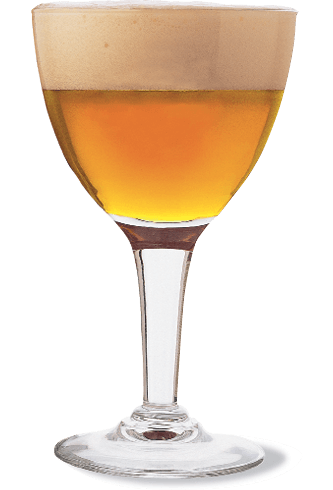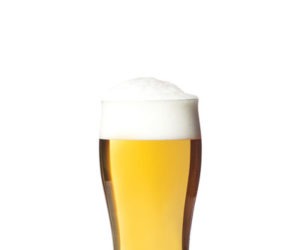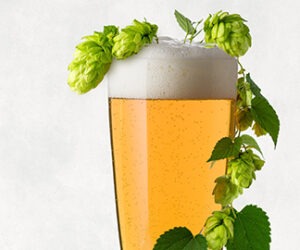Belgian Single
by the numbers
OG: 1.044-1.054
FG:1.004-1.010
SRM:3-5
IBU:25-45
ABV:4.8-6.0%
Trappist monasteries are rightfully known for their excellent beers. Brewed with devotion and service in mind, these beers are used to generate money to sustain religious operations. Most people know about the stronger, frequently exported products such as Westmalle Tripel, Chimay Grande Réserve (blue), and Orval. Monks often make a lower-strength beer for their own consumption, but these beers aren’t widely available or even known. Some monasteries only serve them within their own walls or at their local café. Often these beers have no name. Or they may be called by a Belgian gravity number, its color, or it could have a brand name. La Trappe once made a beer called Enkel (“single” in Dutch), but later changed it to be called Blond. Some people call it Patersbier (Father’s Beer), but that is often associated with a single brand product. It’s also misleading since monks are called “Brother,” not “Father.”
The best commercial examples (typically only found in Belgium) are Westvletern Blond (green cap), Westmalle Extra, St. Bernardus Extra 4, and Achel 5°. Closer to home, the only Trappist brewer outside of Europe, Spencer Brewery in Massachusetts, brews a commercial example named Spencer Trappist Ale.
From a historical standpoint, the modern blond, bitter, and hoppy single is a relatively recent invention. Westvleteren first brewed theirs in 1999, although it did replace older lower-gravity products (Westvleteren Special/6 and Westvleteren 4). So monks have long brewed for themselves, but only recently shared their private brews with outsiders. Some of the other Trappist breweries make a lower-gravity beer for house consumption, but those don’t fit the style as described. Beers such as Chimay Dorée (a 4.8% blond beer spiced with coriander and orange peel, sometimes called Chimay Gold) and Petite Orval (a 3.5% version of Orval, sometimes called Orval Verte or Green, finished with Brettanomyces) do not fit the style but are still the type of table beers enjoyed by monks and guests.
Sensory Profile
The Trappist single style is fairly narrow in definition, which is why some of the other lower-gravity commercial examples are excluded. Remember that many Trappist ales are higher-gravity beers, so this style really is the session beer of the group. The alcohol level can reach as high as 6% but most are lower and are similar to standard-strength beers of the USA and Germany.
Trappist ales in general are highly attenuated and very highly carbonated, and the Trappist single is no exception. Attenuation above 85% is common. Trappist beers generally feature an aggressive fruity-spicy yeast character that most drinkers instantly recognize as “Belgian” in nature. The unique qualities of Trappist singles compared to other Trappist beers is the alcohol level (4.8 to 6.0% ABV), the pale color (3 to 5 SRM), the bitterness level (25 to 45 IBUs), and the hoppy finish.
It’s probably easier to think of a single as being a much smaller version of a Belgian Tripel than anything else – the yeast character and malt profile are similar, but there isn’t the big alcohol component. The balance winds up being like a German Pils – dry, crisp, bitter, and hoppy – although a Pils will obviously have a squeaky-clean yeast character and a smooth lager profile.
The yeast character can have a range of fruit (apple, pear, lemon, orange, peach, apricot) and spice (black pepper, clove). The balance of fruit and spice can vary quite a bit but both components are normally present and could be moderate to fairly strong. The spiciness can also be accentuated by the hop choices, including adding floral, herbal, or spicy notes from Saazer-type (noble) hops.
The malt profile should reflect continental Pilsner malt flavors, with a bready, crackery, grainy, or light honey quality. The body shouldn’t be heavy, and the carbonation is always on the high side. The beer should finish dry and bitter, with the malt, yeast, and hop character lasting through the finish. Alcohol shouldn’t really come into play in the sensory profile.
Brewing Ingredients and Methods
Brewing processes are fairly straightforward for this beer style, although there are a few alternatives. The basic ingredients needed are Pilsner malt (preferably Belgian), Belgian yeast, and Saazer-type hops.
Given that the base malt is likely to be all Pilsner malt, some additional complexity can be obtained by blending base malts from different maltsters. I had a chance to discuss this topic with Stan Hieronymus, author of “Brew Like a Monk,” and he said many brewers will vary the grist from year to year based on the flavors they taste in the grain. Orval does something similar with their base malt. He didn’t mention any particular technical specs they are trying to meet, just an overall flavor. So if you find a need for more complexity, try varying the blend of malts rather than adding in character malts.
Sugar, a common ingredient in many Belgian beer recipes, is generally absent in this beer. Belgians use sugar to raise the gravity, increase the attenuation, and to add additional flavors. None of those are really needed in this beer. Attenuation can be managed through mash controls and yeast selection, and by targeting a lower starting gravity. A low final gravity will give more of a feel of a dry beer than the overall attenuation level. Mashing for attenuation is therefore important. Step mashes or a single infusion mash with a lower conversion temperature (no more than 149 °F or 65 °C) will help achieve this goal.
Classic Trappist yeast strains associated with various Trappist breweries should be used. Each of these strains has a different character and will drive the overall profile. Varying the fermentation temperature of these strains can also change the character of the beer. For example, both Westmalle and Westvleteren use the same yeast, but ferment it differently so the finished character of their beers is different. Warmer isn’t necessarily better, as additional byproducts can be produced. Many fermentation schedules feature a rising temperature curve to encourage full attenuation. So the choice of yeast and the selection of a fermentation temperature are often the most personal choices a brewer can make with Belgian beer recipes. Keep in mind that alcohol-driven byproducts are generally undesirable in this style. Since hops play a major role in the finished profile, selecting varieties that complement the yeast character is important. I would look for those that are spicy or have a stone fruit character rather than those that are overly citrusy, piney, or woody. Saaz is a very common finishing hop in Belgium and is a great choice, but other noble Saazer-type hops can be used, as well as some modern New World hops like Amarillo®. Be careful with too much hop complexity until you understand the yeast character from your selections.
Homebrew Example
The recipe below really is a very simple recipe. It can even be made as a SMaSH (single malt and single hop) beer if you like. However, as with all very simple recipes, ingredient quality matters. Fresher, more authentic ingredients will yield superior results.
Belgian Pilsner malt should constitute the entirety of the grist. To add a bit of complexity (and to mimic several Trappist brewers), consider using malts from different maltsters. For example, you might use Dingemans, Castle, and MFB (Malteries Franco-Belges). You might also choose a little bit of Belgian pale ale malt as part of the grist, as long as the color doesn’t get too dark. You don’t want it creeping towards amber. Unlike many other Belgian beers, do not use sugar in this beer. That’s more appropriate for higher-gravity examples.
As with most Belgian beers, I like to use a step mash to encourage attenuation. I use a short protein rest at 131 °F (55 °C) to improve clarity, then a main conversion rest at 145 °F (63 °C). I finish with a short rest at 158 °F (70 °C) to build a little body. A well-attenuated beer needs a little body to avoid seeming watery, but in no event should this beer finish sweet.
Saaz hops (or a US equivalent such as Sterling) provide a nice spicy-herbal aroma that pairs well with the yeast. The bittering hops can also be Saaz if you want to make a SMaSH beer, or can be another European hop such as Styrian Goldings. I use one bittering addition and one aroma addition at knockout, but this style could also be made using the first wort hop technique to boost the hop flavor.
The most critical ingredient for this style is the yeast. My favorite is Wyeast 3787 (Trappist Style High Gravity), which is the yeast from Westmalle that is also used by Westvleteren and many other breweries. It has great attenuation and gives a spicy complex yeast profile that is instantly recognizable as Belgian. This yeast can be a little finicky, so never try to limit the temperature. Pitch it at a lower temperature and let it free rise as it wants. If you try to constrain the fermentation temperature, it will often stop fermenting and leave you with an under-attenuated beer. It is also well-known for having a sticky kräusen, so be sure you have sufficient headspace in your fermenter or be prepared to use a blowoff tube.
Belgian Single
(5 gallons/19 L, all-grain)
OG = 1.049 FG = 1.007
IBU = 35 SRM = 3 ABV = 5.5%
Ingredients
10 lbs. (4.5 kg) Belgian Pilsner malt
9 AAU Styrian Goldings hops
(60 min.) (2 oz./57 g at 4.5% alpha acids)
2 oz. (57 g) Czech Saaz hops (0 min.)
Wyeast 3787 (Trappist High Gravity) or White Labs WLP530 (Abbey Ale) yeast
1 cup corn sugar (if priming)
Step by Step
Two or three days before brew day, make a 1-qt. (1-L) yeast starter, aerating the wort thoroughly (preferably with oxygen) before pitching the yeast. For added complexity, consider using Pilsner malts from multiple maltsters.
On brew day, prepare your ingredients; mill the grain, measure your hops, and prepare your water. This recipe uses Reverse Osmosis (RO) water. Add ¼ tsp. of 10% phosphoric acid per 5 gallons (19 L) of brewing water, or until water measures pH 5.5 at room temperature. Add 3/4 tsp. calcium chloride (CaCl2) and ¼ tsp. calcium sulfate (CaSO4) to the mash.
This recipe uses a multi-step mash with a mashout. On brew day, mash in all the grains at 131 °F (55 °C) in 15 qts. (14 L) of water and hold this temperature for 10 minutes. Raise the temperature by infusion or direct heating to 145 °F (63 °C) for 40 minutes, then to 158 °F (70 °C) for 10 minutes.
Finally, raise to 168 °F (76 °C) for 10 minutes to mashout, recirculating. Fly sparge with 168 °F (76 °C) water until 6.5 gallons (25 L) of wort is collected.
Boil the wort for 90 minutes, adding the hops at times indicated in the recipe. Once the boil is complete, chill to 64 °F (18 °C).
Oxygenate, then pitch the yeast starter. Start fermentation at 64 °F (18 °C) but allow the temperature to free rise until fermentation is complete. Rack the beer and then prime and bottle condition, or keg and force carbonate to 3 volumes. If bottle conditioning, warm condition the beer at 72 °F (22 °C) for one to two weeks before chilling.
Belgian Single
(5 gallons/19 L, partial mash)
OG = 1.049 FG = 1.007
IBU = 35 SRM = 3 ABV = 5.5%
Ingredients
3.5 lbs. (1.6 kg) Belgian Pilsner malt
3.5 lbs. (1.6 kg) Pilsen dried malt extract
9 AAU Styrian Goldings hops
(60 min.) (2 oz./57 g at 4.5% alpha acids)
2 oz. (57 g) Czech Saaz hops (0 min.)
Wyeast 3787 (Trappist High Gravity) or White Labs WLP530 (Abbey Ale) yeast
1 cup corn sugar (if priming)
Step by Step
Two or three days before brew day, make a 1-qt. (1-L) yeast starter, aerating the wort thoroughly (preferably with oxygen) before pitching the yeast. For added complexity, consider using Pilsner malts from multiple maltsters.
This recipe uses a multi-step mash with a mashout. On brew day, place the crushed grain in a large muslin bag. Mix grains in strike water so that the mash temperature settles at 145 °F (63 °C) and hold for 40 minutes. Taking care not to scorch the bag, raise the mash temperature to 158 °F (70 °C) and hold for 10 minutes. Finally raise to 168 °F (76 °C) for 10 minutes to mashout. Remove the grain bag and rinse the grains with 1 gallon (4 L) hot water. Stir in the dried malt extract, then top off to 6.5 gallons (25 L) of wort.
Boil the wort for 90 minutes, adding the hops at times indicated in the recipe. Chill to 64 °F (18 °C).
Oxygenate, then pitch the yeast starter. Start fermentation at 64 °F (18 °C) but allow the temperature to free rise until fermentation is complete. Rack the beer and then prime and bottle condition, or keg and force carbonate to 3 volumes. If bottle conditioning, warm condition the beer at 72 °F (22 °C) for one to two weeks before chilling.
Belgian Single
(5 gallons/19 L, extract only)
OG = 1.049 FG = 1.007
IBU = 35 SRM = 3.5 ABV = 5.5%
Ingredients
6.6 lbs. (3 kg) Pilsner liquid malt extract
9 AAU Styrian Goldings hops
(60 min.) (2 oz./57 g at 4.5% alphaacid)
2 oz. (57 g) Czech Saaz hops (0 min.)
Wyeast 3787 (Trappist Style High Gravity) or White Labs WLP530 (Abbey Ale)yeast
1 cup corn sugar (if priming)
Step by Step
Two or three days before brew day, make a 1-qt. (1-L) yeast starter, aerating the wort thoroughly (preferably with oxygen) before pitching the yeast.
On brew day, use 6 gallons (23 L) of water in the brew kettle; heat to 158 °F (70 °C). Turn off the heat, add the malt extract and stir thoroughly to dissolve the extract completely. You do not want to feel liquid extract at the bottom of the kettle when stirring with your spoon.
Turn the heat back on and bring to a boil. Boil the wort for 60 minutes, adding the hops at the times indicated in the recipe.
Once the boil is complete, chill to 64 °F (18 °C). Oxygenate, then pitch the yeast starter. Start fermentation at 64 °F (18 °C) but allow the temperature to free rise until fermentation is complete. Rack the beer after fermentation.
Prime and bottle condition, or keg and force carbonate to 3 volumes. If bottle conditioning, warm condition the beer at 72 °F (22 °C) for one to two weeks before chilling.




